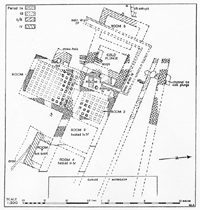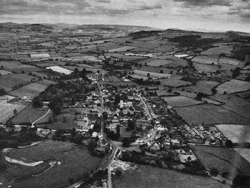
|
| Multi-period plan of the Roman bathhouse at Leintwardine. The curse tablets were found in the narrow drain in room 5, one of the cold rooms in the late Roman bathhouse. (Stanhope 1968, Fig. 31) |

|
| Leintwardine, seen from the south. The bathhouse was situated just outside the Roman and modern settlement, by the river in the bottom left of the picture. (Stanhope 1968, Plate VA) |
Leintwardine (SO403740) was a Roman 'small town' (Bravonium) in Herefordshire, on the road between Wroxeter, civitas capital of the Cornovii (Uriconium) and Kenchester (Magnis), 40km from the former and 35km from the latter. The cluster of early Roman forts round about demonstrates its strategic importance. The Roman settlement lies beneath a modern village. The town, which perhaps came into being as a vicus (civilian settlement) for a nearby fort, was surrounded by an earth rampart in the late second century AD.
The curse tablet was found in a bathhouse, first built in AD 140, enlarged in AD 160, which found itself outside the town when the rampart was constructed. It comprised a hot room (room 1), warm room (room 2), and cold plunge bath, with the rooms at the east end perhaps serving for changing. By the fourth century AD the bathhouse seemed to have fallen into disrepair. The hypocausts of rooms 1 and 2 were filled in and a new drain (F12) was constructed in room 5, using the tiles from the hypocausts of the other room. The rooms at the west end served as the cold suite and at the east end hot rooms seem to have been constructed in rooms 3 and 4. The tablets were found in the top fill of drain F12. Few associated finds were recorded. It is not clear if this fill relates to final use of the bathhouse or to the period of abandonment. The preference for watery contexts is shared by other curse tablets, although no other instances have yet been recovered from baths.